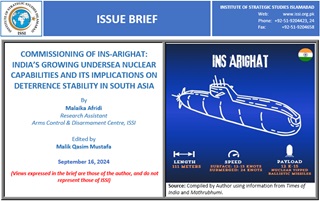India’s modernization of its undersea nuclear capabilities is shifting the South Asian arms race to the sea, underscored by the recent commission of its second Nuclear-powered Ballistic Missile Submarine (SSBN), INS Arighat. Simultaneously, the government of India has authorized a project to develop six nuclear attack submarines (SSNs), emphasizing India’s demonstration of strength and commitment to advancing its undersea nuclear capabilities. The introduction of second-strike capability at sea serves as a significant development in the region’s security framework, which has serious implications. Similarly, India’s current modernization of undersea nuclear capabilities along with naval buildup is reflective of its aspirations to gain global power status and establish a blue-water fleet. These aspirations, as a result, trigger instability in the Indian Ocean Region (IOR) and impact Pakistan’s threat perception, as its main security concerns revolve around India.
The INS Arighat, a 6000-tonne submarine built at Visakhapatnam’s Ship Building Centre, recently completed extensive trials and upgrades.[1] It was commissioned on August 29, 2024, into the Indian Navy, joining the INS Arihant, India’s first SSBN, which was fully operational in 2018.[2] The enhanced features and capabilities of INS Arighat have been developed to strengthen India’s undersea nuclear capabilities. It is equipped with advanced technology with a maximum surface speed of 12-15 knots and a submerged speed of up to 24 knots.[3] It features four launch tubes that are capable of holding up to four K-4 Submarine-launched Ballistic Missiles (SLBMs) with a range of approximately 3500 kilometers. It is also equipped to carry 12 K-15 nuclear-tipped ballistic missiles that can strike targets over 750 kilometers.[4]















